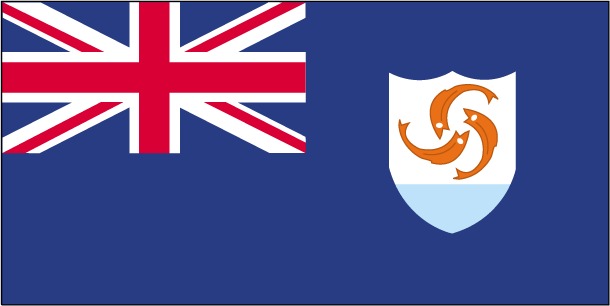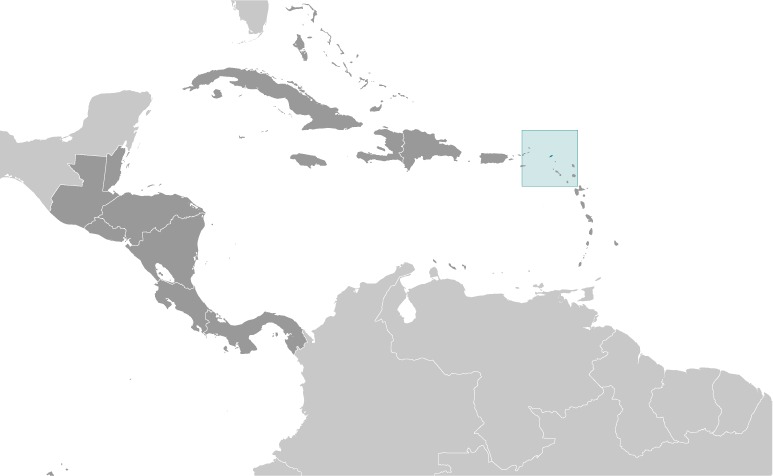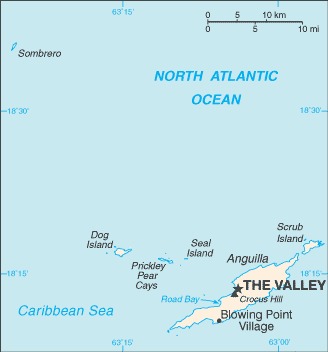


Central America ::
Anguilla
-
Introduction :: Anguilla
-
Background:Colonized by English settlers from Saint Kitts in 1650, Anguilla was administered by Great Britain until the early 19th century, when the island - against the wishes of the inhabitants - was incorporated into a single British dependency along with Saint Kitts and Nevis. Several attempts at separation failed. In 1971, two years after a revolt, Anguilla was finally allowed to secede; this arrangement was formally recognized in 1980, with Anguilla becoming a separate British dependency. On 7 September 2017, the island suffered extensive damage from Hurricane Irma, particularly to communications and residential and business infrastructure.
-
Geography :: Anguilla
-
Location:Caribbean, islands between the Caribbean Sea and North Atlantic Ocean, east of Puerto RicoGeographic coordinates:18 15 N, 63 10 WMap references:Central America and the CaribbeanArea:total: 91 sq kmland: 91 sq kmwater: 0 sq kmcountry comparison to the world: 226Area - comparative:about one-half the size of Washington, DCLand boundaries:0 kmCoastline:61 kmMaritime claims:territorial sea: 3 nmexclusive fishing zone: 200 nmClimate:tropical; moderated by northeast trade windsTerrain:flat and low-lying island of coral and limestoneElevation:lowest point: Caribbean Sea 0 mhighest point: Crocus Hill 73 mNatural resources:salt, fish, lobsterLand use:agricultural land: 0% (2016 est.)arable land: 0% (2016 est.) / permanent crops: 0% (2016 est.) / permanent pasture: 0% (2016 est.)forest: 61.1% (2016 est.)other: 38.9% (2016 est.)Irrigated land:0 sq km (2012)Population distribution:most of the population is concentrated in The Valley in the center of the island; settlmement is fairly uniform in the southwest, but rather sparce in the northeastNatural hazards:frequent hurricanes and other tropical storms (July to October)Environment - current issues:supplies of potable water sometimes cannot meet increasing demand largely because of poor distribution systemGeography - note:the most northerly of the Leeward Islands in the Lesser Antilles
-
People and Society :: Anguilla
-
Population:18,090 (July 2020 est.)country comparison to the world: 219Nationality:noun: Anguillan(s)adjective: AnguillanEthnic groups:African/Black 85.3%, Hispanic 4.9%, mixed 3.8%, White 3.2%, East Indian/Indian 1%, other 1.6%, unspecified 0.3% (2011 est.)note: data represent population by ethnic originLanguages:English (official)Religions:Protestant 73.2% (includes Anglican 22.7%, Methodist 19.4%, Pentecostal 10.5%, Seventh Day Adventist 8.3%, Baptist 7.1%, Church of God 4.9%, Presbyterian 0.2%, Brethren 0.1%), Roman Catholic 6.8%, Jehovah's Witness 1.1%, other Christian 10.9%, other 3.2%, unspecified 0.3%, none 4.5% (2011 est.)Age structure:0-14 years: 21.63% (male 1,991/female 1,922)15-24 years: 13.9% (male 1,269/female 1,246)25-54 years: 42.27% (male 3,428/female 4,218)55-64 years: 12.42% (male 993/female 1,254)65 years and over: 9.78% (male 874/female 895) (2020 est.)population pyramid:The World Factbook Field Image ModalCentral America :: Anguilla PrintImage DescriptionThis is the population pyramid for Anguilla. A population pyramid illustrates the age and sex structure of a country's population and may provide insights about political and social stability, as well as economic development. The population is distributed along the horizontal axis, with males shown on the left and females on the right. The male and female populations are broken down into 5-year age groups represented as horizontal bars along the vertical axis, with the youngest age groups at the bottom and the oldest at the top. The shape of the population pyramid gradually evolves over time based on fertility, mortality, and international migration trends.
For additional information, please see the entry for Population pyramid on the Definitions and Notes page under the References tab.Median age:total: 35.7 yearsmale: 33.7 yearsfemale: 37.6 years (2020 est.)country comparison to the world: 81Population growth rate:1.86% (2020 est.)country comparison to the world: 53Birth rate:12.2 births/1,000 population (2020 est.)country comparison to the world: 157Death rate:4.8 deaths/1,000 population (2020 est.)country comparison to the world: 203Net migration rate:11.1 migrant(s)/1,000 population (2020 est.)country comparison to the world: 6Population distribution:most of the population is concentrated in The Valley in the center of the island; settlmement is fairly uniform in the southwest, but rather sparce in the northeastUrbanization:urban population: 100% of total population (2020)rate of urbanization: 0.9% annual rate of change (2015-20 est.)Major urban areas - population:1,000 THE VALLEY (capital) (2018)Sex ratio:at birth: 1.03 male(s)/female0-14 years: 1.04 male(s)/female15-24 years: 1.02 male(s)/female25-54 years: 0.81 male(s)/female55-64 years: 0.79 male(s)/female65 years and over: 0.98 male(s)/femaletotal population: 0.9 male(s)/female (2020 est.)Infant mortality rate:total: 3.3 deaths/1,000 live birthsmale: 3.6 deaths/1,000 live birthsfemale: 2.9 deaths/1,000 live births (2020 est.)country comparison to the world: 202Life expectancy at birth:total population: 81.8 yearsmale: 79.2 yearsfemale: 84.5 years (2020 est.)country comparison to the world: 26Total fertility rate:1.74 children born/woman (2020 est.)country comparison to the world: 160Drinking water source:improved: urban: 97.5% of populationtotal: 97.5% of populationunimproved: urban: 2.5% of populationtotal: 2.5% of population (2017 est.)Sanitation facility access:improved: urban: 99.1% of populationtotal: 99.1% of populationunimproved: urban: 0.9% of populationtotal: 0.9% of population (2017 est.)HIV/AIDS - adult prevalence rate:NAHIV/AIDS - people living with HIV/AIDS:NAHIV/AIDS - deaths:NAEducation expenditures:NA -
Government :: Anguilla
-
Country name:conventional long form: noneconventional short form: Anguillaetymology: the name Anguilla means "eel" in various Romance languages (Spanish, Italian, Portuguese, French) and likely derives from the island's lengthy shapeDependency status:overseas territory of the UKGovernment type:parliamentary democracy (House of Assembly); self-governing overseas territory of the UKCapital:name: The Valleygeographic coordinates: 18 13 N, 63 03 Wtime difference: UTC-4 (1 hour ahead of Washington, DC, during Standard Time)etymology: name derives from the capital's location between several hillsAdministrative divisions:none (overseas territory of the UK)Independence:none (overseas territory of the UK)National holiday:Anguilla Day, 30 May (1967)Constitution:history: several previous; latest 1 April 1982amendments: amended 1990Legal system:common law based on the English modelCitizenship:see United KingdomSuffrage:18 years of age; universalExecutive branch:chief of state: Queen ELIZABETH II (since 6 February 1952); represented by Governor Tim FOY (since August 2017)head of government: Premier Dr. Ellis WEBSTER (since 30 June 2020); note - starting in 2019, the title of head of government was changed to premier from chief minister of Anguillacabinet: Executive Council appointed by the governor from among elected members of the House of Assemblyelections/appointments: the monarchy is hereditary; governor appointed by the monarch; following legislative elections, the leader of the majority party or majority coalition usually appointed premier by the governorLegislative branch:description: unicameral House of Assembly (11 seats; 7 members directly elected in single-seat constituencies by simple majority vote, 2 appointed by the governor, and 2 ex officio members - the attorney general and deputy governor; members serve five-year terms)elections: last held on 29 June 2020 (next to be held in 2025)election results: percent of vote by party - NA; seats by party - APM 7, AUF 4; composition - NAJudicial branch:highest courts: the Eastern Caribbean Supreme Court (ECSC) is the superior court of the Organization of Eastern Caribbean States; the ECSC - headquartered on St. Lucia - consists of the Court of Appeal - headed by the chief justice and 4 judges - and the High Court with 18 judges; the Court of Appeal is itinerant, travelling to member states on a schedule to hear appeals from the High Court and subordinate courts; High Court judges reside in the member states, though none on Anguillajudge selection and term of office: Eastern Caribbean Supreme Court chief justice appointed by Her Majesty, Queen ELIZABETH II; other justices and judges appointed by the Judicial and Legal Services Commission; Court of Appeal justices appointed for life with mandatory retirement at age 65; High Court judges appointed for life with mandatory retirement at age 62subordinate courts: Magistrate's Court; Juvenile CourtPolitical parties and leaders:Anguilla Democratic Party or ADP
Anguilla National Alliance or ANA
Anguilla Progressive Movement or APM [Dr. Ellis WEBSTER]; prior to 2019, it was known as the Anguilla United Movement or AUM
Anguilla United Front or AUF [Victor BANKS] (alliance includes ADP, ANA)
Democracy, Opportunity, Vision, and Empowerment Party or DOVE [Sutcliffe HODGE]International organization participation:Caricom (associate), CDB, Interpol (subbureau), OECS, UNESCO (associate), UPUDiplomatic representation in the US:none (overseas territory of the UK)Diplomatic representation from the US:telephone: [1] (246) 227-4000embassy: none (overseas territory of the UK); alternate contact is the US Embassy in Barbados [1] (246) 227-4000Flag description:blue, with the flag of the UK in the upper hoist-side quadrant and the Anguillan coat of arms centered in the outer half of the flag; the coat of arms depicts three orange dolphins in an interlocking circular design on a white background with a turquoise-blue field below; the white in the background represents peace; the blue base symbolizes the surrounding sea, as well as faith, youth, and hope; the three dolphins stand for endurance, unity, and strengthNational symbol(s):dolphinNational anthem:name: God Bless Anguillalyrics/music: Alex RICHARDSONnote: local anthem adopted 1981; as a territory of the United Kingdom, "God Save the Queen" is official (see United Kingdom)
-
Economy :: Anguilla
-
Economic overview:Anguilla has few natural resources, is unsuited for agriculture, and the economy depends heavily on luxury tourism, offshore banking, lobster fishing, and remittances from emigrants. Increased activity in the tourism industry has spurred the growth of the construction sector contributing to economic growth. Anguillan officials have put substantial effort into developing the offshore financial sector, which is small but growing. In the medium term, prospects for the economy will depend largely on the recovery of the tourism sector and, therefore, on revived income growth in the industrialized nations as well as on favorable weather conditions.GDP real growth rate:-8.5% (2009 est.)country comparison to the world: 220Inflation rate (consumer prices):1.3% (2017 est.)-0.6% (2016 est.)country comparison to the world: 77GDP (purchasing power parity) - real:$175.4 million (2009 est.)$191.7 million (2008 est.)$108.9 million (2004 est.)GDP (official exchange rate):$175.4 million (2009 est.)GDP - per capita (PPP):$12,200 (2008 est.)country comparison to the world: 105GDP - composition, by sector of origin:agriculture: 3% (2017 est.)industry: 10.5% (2017 est.)services: 86.4% (2017 est.)GDP - composition, by end use:household consumption: 74.1% (2017 est.)government consumption: 18.3% (2017 est.)investment in fixed capital: 26.8% (2017 est.)investment in inventories: 0% (2017 est.)exports of goods and services: 48.2% (2017 est.)imports of goods and services: -67.4% (2017 est.)Ease of Doing Business Index scores:Agriculture - products:small quantities of tobacco, vegetables; cattle raisingIndustries:tourism, boat building, offshore financial servicesIndustrial production growth rate:4% (2017 est.)country comparison to the world: 75Labor force:6,049 (2001)country comparison to the world: 218Labor force - by occupation:agriculture: 74.1%industry: 3%services: 18%agriculture/fishing/forestry/mining: 4% (2000 est.)manufacturing: 3% (2000 est.)construction: 18% (2000 est.)transportation and utilities: 10% (2000 est.)commerce: 36% (2000 est.)Unemployment rate:8% (2002)country comparison to the world: 124Population below poverty line:23% (2002 est.)Household income or consumption by percentage share:lowest 10%: NAhighest 10%: NABudget:revenues: 81.92 million (2017 est.)expenditures: 80.32 million (2017 est.)Taxes and other revenues:46.7% (of GDP) (2017 est.)country comparison to the world: 19Budget surplus (+) or deficit (-):0.9% (of GDP) (2017 est.)country comparison to the world: 34Public debt:20.1% of GDP (2015 est.)20.8% of GDP (2014 est.)country comparison to the world: 189Fiscal year:1 April - 31 MarchCurrent account balance:-$23.2 million (2017 est.)-$25.3 million (2016 est.)country comparison to the world: 73Exports:$7.9 million (2017 est.)$3.9 million (2016 est.)country comparison to the world: 216Exports - commodities:lobster, fish, livestock, salt, concrete blocks, rumImports:$186.2 million (2017 est.)$170.1 million (2016 est.)country comparison to the world: 211Imports - commodities:fuels, foodstuffs, manufactures, chemicals, trucks, textilesReserves of foreign exchange and gold:$76.38 million (31 December 2017 est.)$48.14 million (31 December 2015 est.)country comparison to the world: 183Debt - external:$41.04 million (31 December 2013)$8.8 million (1998)country comparison to the world: 195Exchange rates:East Caribbean dollars (XCD) per US dollar -2.7 (2017 est.)2.7 (2016 est.)2.7 (2015 est.)2.7 (2014 est.)2.7 (2013 est.)
-
Communications :: Anguilla
-
Telephones - fixed lines:total subscriptions: 7,461subscriptions per 100 inhabitants: 42.02 (2019 est.)country comparison to the world: 196Telephones - mobile cellular:total subscriptions: 32,332subscriptions per 100 inhabitants: 182.09 (2019 est.)country comparison to the world: 209Telecommunication systems:general assessment: modern internal telephone system with fiber-optic trunk lines; telecom sector provides a relatively high contribution to overall GDP; numerous competitors licensed, but small and localized; major growth sectors include the mobile telephony and data segments (2020)domestic: fixed-line teledensity is about 42 per 100 persons; mobile-cellular teledensity is roughly 182 per 100 persons (2019)international: country code - 1-264; landing points for the SSCS, ECFS, GCN and Southern Caribbean Fiber with submarine cable links to Caribbean islands and to the US; microwave radio relay to island of Saint Martin/Sint Maarten (2019)note: the COVID-19 outbreak is negatively impacting telecommunications production and supply chains globally; consumer spending on telecom devices and services has also slowed due to the pandemic's effect on economies worldwide; overall progress towards improvements in all facets of the telecom industry - mobile, fixed-line, broadband, submarine cable and satellite - has moderatedBroadcast media:1 private TV station; multi-channel cable TV subscription services are available; about 10 radio stations, one of which is government-ownedInternet country code:.aiInternet users:total: 14,211percent of population: 81.57% (July 2018 est.)country comparison to the world: 213
-
Transportation :: Anguilla
-
National air transport system:number of registered air carriers: 2 (2020)inventory of registered aircraft operated by air carriers: 4Civil aircraft registration country code prefix:VP-A (2016)Airports:1 (2020)country comparison to the world: 210Airports - with paved runways:total: 1 (2020)1,524 to 2,437 m: 1Roadways:total: 175 km (2004)paved: 82 km (2004)unpaved: 93 km (2004)country comparison to the world: 209Merchant marine:total: 2by type: other 2 (2019)country comparison to the world: 172Ports and terminals:major seaport(s): Blowing Point, Road Bay
-
Military and Security :: Anguilla
-
Military - note:defense is the responsibility of the UK
-
Transnational Issues :: Anguilla
-
Disputes - international:
none
Illicit drugs:transshipment point for South American narcotics destined for the US and Europe


